Affiliate disclosure: This post may contain affiliate links. Please see our Privacy Policy.
Acorn ice cream is a fun foraged food recipe, and it’s a good way to get children excited about both foraging and the natural world.
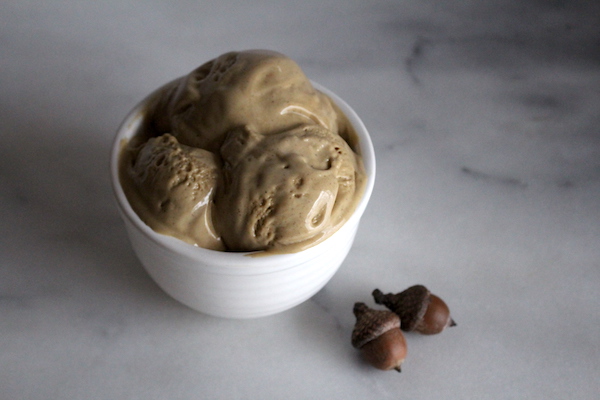
I’ll admit I’m not above bribery when it comes to getting my children excited about certain things.
When I really needed my pre-school aged daughter’s help gathering dandelion blossoms for a project, I promised that we’d use some of them to make dandelion ice cream. She was ecstatic, and gathered so many blossoms that we had enough for literally dozens of dandelion recipes.
We made dandelion jelly, dandelion cookies, dandelion gummy bears…plus, of course, dandelion wine for my husband and I, along with dandelion soda for her.
A similar strategy worked all summer long as we gathered wild fruits, there was an ice cream recipe for almost all of them. We even made chanterelle mushroom ice cream, which tastes like apricots.
Mostly wild edible berries, of course, along with a few wild flower ice creams too. Haskap berry ice cream was pretty spectacular, and Saskatoon berries make a darn good batch too.
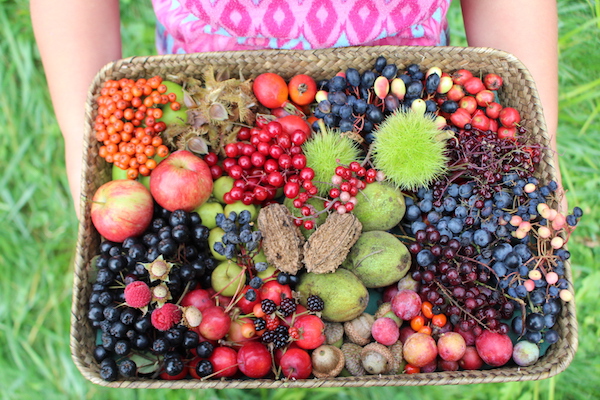
Then in the fall, when acorn season came around, we began collecting them from the trees around her favorite playground. I explained we were going to make acorn flour, and she looked at me skeptically…
“There’s flour in ice cream?” She asked.
No, there’s not flour in ice cream. Acorn flour is useful for all manner of baked goods, including these spectacular acorn flour chocolate chip cookies, but it’s not all that great for making ice cream.
But, it did get me thinking. My little ice cream fiend needed her fix, and she help me gather around 100 pounds over the course of the season from dozens of trees near our home.
How would you make ice cream from acorns?
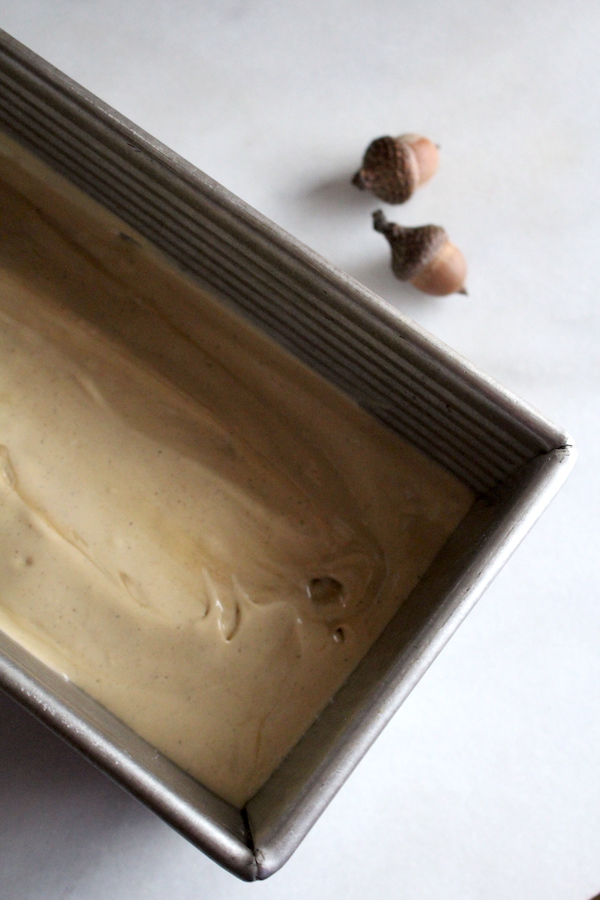
Preparing Acorns for Ice Cream
As with any acorn recipe, the acorns need to be leached before they can be eaten. Cold leaching takes 10-14 days and a lot of water changes, and yields acorns with un-cooked starches that are good for making flour.
The thing is, I don’t need raw starches or flour, I need acorn flavor.
Hot leaching is another method of processing acorns, and it’s a lot faster.
Start by cracking the acorns, removing the shells and papery seed coats, and then simmering them in plenty of water.
They’ll need to simmer for several hours with many water changes, and exactly how long depends on the acorns you gather (as some trees have a lot more tannin than others).
A good rule of thumb is to simmer for about 30 minutes, then strain and change the water. After about 3 to 6 hours, you should have fully hot leached acorns.
At the three hour mark, you can start testing the strained acorns by nibbling them. Tannins are less of a taste than a “mouthfeel” and it’ll make your mouth pucker and feel dry. If you get any tannin notes at all, continue simmering for another round or two and then test again.
Once you’ve fully hot leached the acorns, strain and rinse them. At this point, they’re ready to use for ice cream.
Or really, any other acorn recipe that doesn’t require flour. Think things like acorn hummus, meatless acorn “hamburger” patties or even acorn soup. At this point, they’re more like beans than nuts in texture, unless you roast them to dry them back out (which I’ll discuss in a moment).
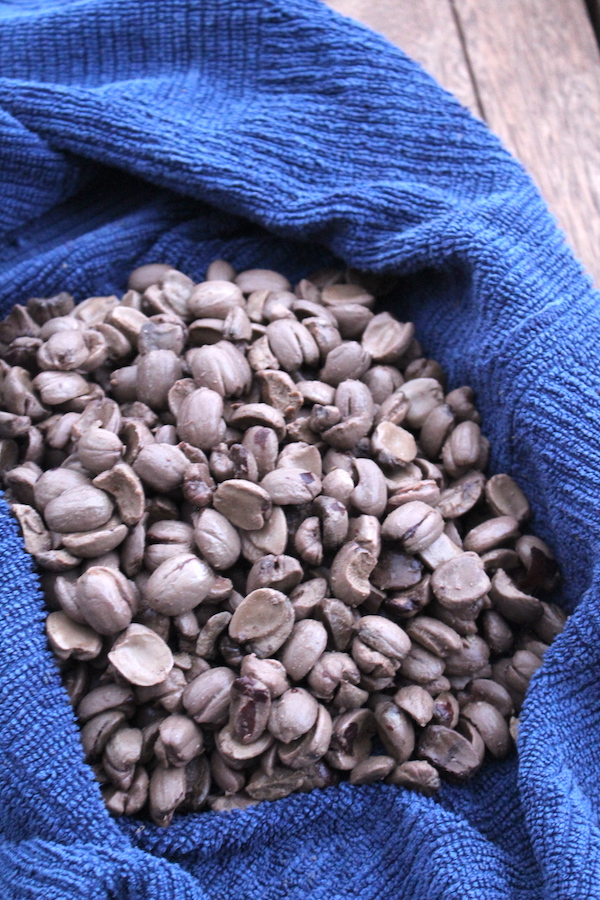
How to Make Acorn Ice Cream
I did a bit of research, and it turns out there’s two different ways to go about making ice cream from acorns.
The first way, is to make something that’s basically acorn nut butter, and add that to ice cream.
It obviously won’t taste the same as peanut butter or almond butter, and acorns, in fact, are a lot more starchy than most nuts we find at the grocery store.
They’re more like chestnuts, which are also traditionally harvested and made into chestnut flour since they’re so high in starch (and were historically a lot cheaper for peasants than wheat flour). Luckily, chestnuts don’t require leaching, so that’s one reason why they’re a lot more popular than acorns in the middle ages (though acorns were eaten too).
I’d suggest using hot leached acorns in place of the cooked chestnuts in this recipe for chestnut ice cream.
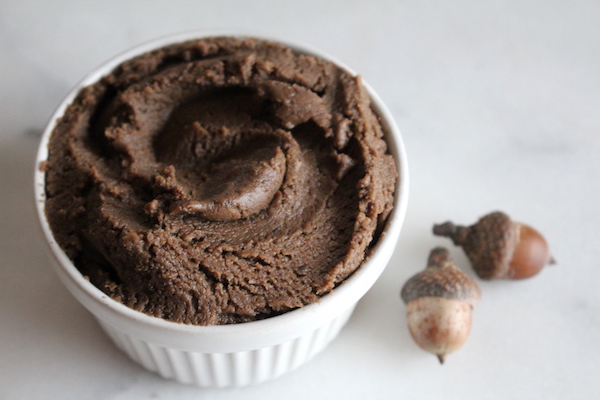
The second method is to simply extract the flavor from roasted acorns, as you do when making acorn coffee.
Acorns still need to be hot leached to remove tannins, but then they’re roasted in the oven at 375 to 400 degrees F until fully dry and toasted, around 30-45 minutes, stirring occasionally so they roast evenly.
The actual roasting time depends on your tastes, and just like when you’re roasting coffee. At a minimum, they need to be roasted until they’re fully dry and you can “crack” one in half with your hands because it’s become brittle dry.
After that, further roasting is all about flavor, and I went with reasonably dark (but not burned). For my acorns, that meant about 35 minutes at 375 degrees.
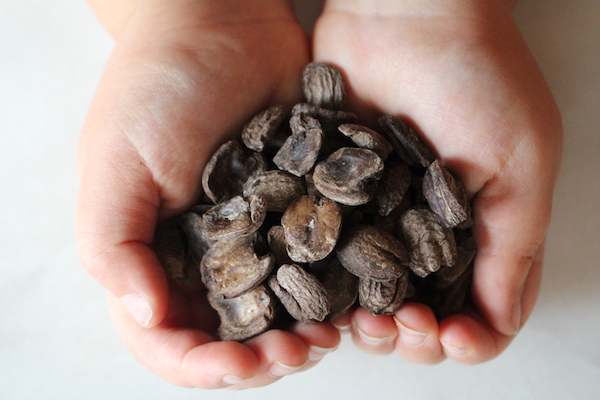
I know, this is a lot, but stick with me here. It’s a pretty involved project, and my kids were into every step of this transformation. Beats the heck out of loafing on the couch watching cartoons any day…
So now that the acorns have been leached and roasted, they’re ground into “acorn coffee” after the roasted acorns have completely cooled.
Historically, acorn coffee was used as a caffeine free coffee substitute during times of war and famine, and though it lacks caffeine, it’s somewhat similar in flavor. Only somewhat similar though, and it doesn’t honestly taste all that much like coffee to me.
It’s milder in some ways than coffee, with more earthy notes, and not all that different from other wild coffee substitutes (like dandelion root coffee).
The lack of caffeine means it’s a good option for kids in ice cream, still giving rich, warm flavor but without the stay up all night kick.
Grind the roasted acorns in a coffee grinder until you have a a coarse grind.
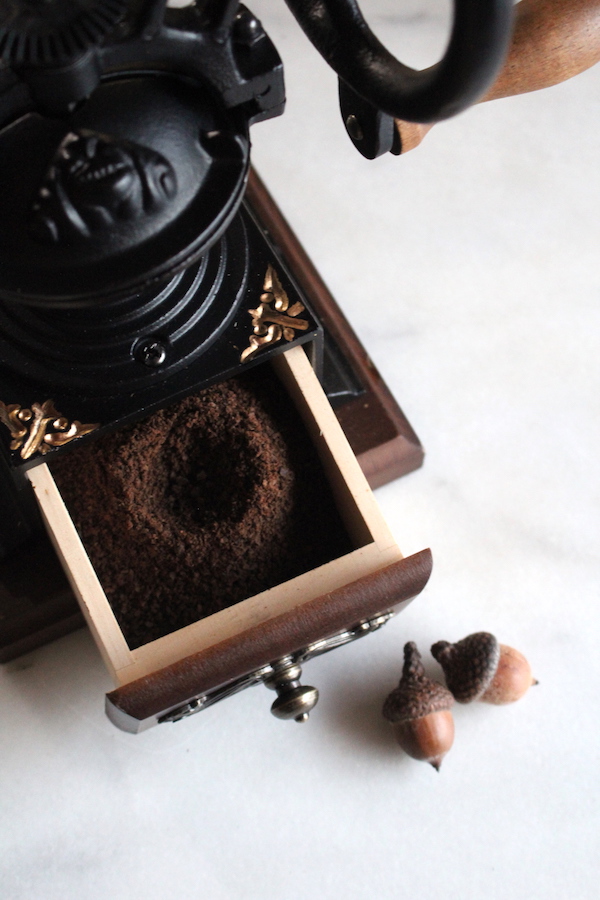
At this point, you can use the “acorn coffee” grounds in place of regular coffee grounds in a coffee ice cream recipe.
I like this method (as opposed to the nut butter method) for two reasons:
- First, acorn nut butter doesn’t have nearly as much flavor as roasted acorns. It’s pretty mild honestly, and a little starchy.
- Second, that starchy-ness makes it clump a bit and it’s not easy to get a smooth ice cream when using acorn butter puree.
Roasting the acorns and then infusing them into the cream, then straining out the solids, is a great way to get incredible flavor without sacrificing the texture of the finished ice cream.
We’ve made this acorn ice cream for the past few years, and it’s one of my daughter’s favorites.
When we’re out on a walk, she always bounces with delight when she sees the first acorns on the ground. She’ll immediately begin collecting them, singing a little made up song about how acorn season means it’s ice cream time.

Acorn Ice Cream
Equipment
Ingredients
- 2 cups heavy cream
- 2 cups whole milk
- 3-4 Tbsp roasted acorns, ground ("acorn coffee") * see note
- 6 egg yolks
- tiny pinch salt
Instructions
- Before making acorn ice cream, you need to hot leach and then roast the acorn nut meats. They're then ground into "acorn coffee" before infusing. This step cannot be skipped, unless you purchase already made acorn coffee. See the notes below for instructions on preparing the acorns.
- You'll also need an ice cream maker to make this recipe. This is the one I use.
- Place the milk (but not the cream) in a saucepan and add the roasted ground acorns. Gently warm the the liquid until it's just starting to steam, around 180 degrees F. (Do not boil)
- Turn off the heat and allow the acorns to steep for about 20 minutes.
- Strain through a fine mesh strainer.
- In a separate container, whisk the egg yolks and cream together until fully incorporated.
- Return the slightly cooled, strained acorn coffee infused milk to a clean saucepan. Slowly add the cream/egg yolk mixture a little at a time, whisking continiously. (Don't add it too fast of the eggs will cook into scrambled eggs.)
- Once all the egg mixture is added, keep whisking and slowly heat the mixture over very low heat until it reaches 170 degrees F and begins to thicken so that it coats the back of a spoon. This is the ice cream base, and once thickened slightly it can be removed from the heat.
- Pour the mixture into a bowl, cover completely and refrigerate until chilled. Once chilled, freeze in an ice cream maker according to the manufacturers instructions.
Notes
Foraged Food Recipes
Looking for more ways to incorporate wild foods into your diet?
- Japanese Knotweed Gin and Tonic
- Elderberry Pie
- Elderflower Cordial
- 12+ Chokecherry Recipes
- Chokecherry Jelly (and Jam)
Fall Foraging Guides
Acorns aren’t the only thing you can forage in the fall!
- Foraging Nannyberries
- Foraging Partridgeberries
- Foraging Barberries
- Foraging Highbush Cranberries
- Foraging Autumn Olive
- Foraging Black Walnuts
- Foraging Butternuts















Just a curiosity kind of question about acorns. Reading about the tannins, my little ADHD brain (seriously ADHD brain) kicked in and I thought, “I wonder if the tannins in acorns would work in winemaking?”
So, you know lots of things. Have you ever tried using acorns to introduce tannins into wine?
You definitely can use acorn. We have a post here that has a bunch of acorn recipes. There is even a link to an acorn wine recipe that talks about this very thing. https://practicalselfreliance.com/acorn-recipes/
I just stumbled across a source of good sized acorns, so I’m anxious to try out your recipes. I had found much smaller acorns several years ago and tried to leech them, but never got rid of the tannins. Hopefully these bigger guys will work out better. Love your blog!
Good luck with them. We’re so glad you’re enjoying the blog.
I love acorn ice cream! I have two acorn ice cream recipes in my acorn foraging book (Acorn Foraging: Everything You Need to Know to Harvest One of Autumn’s Best Wild Edible Foods, with Recipes, Photographs and Step-By-Step Instructions). One is very similar to this and is a traditional recipe and the other one is very quick and easy for a vegan version that also uses maple syrup. I have the recipe for that one on our family foraging blog. A similar method also makes the best coffee creamer! I love acorns, as you’ve probably guessed. 🙂
Hi Alicia! How did I miss that!?!? I love your acorn book, it’s my favorite by far. We REALLY enjoyed your acorn chocolate chip cookies, and I even wrote about them here: https://practicalselfreliance.com/acorn-flour-chocolate-chip-cookies/
That looks and sounds delicious and intriguing.
I’ve been making an oak leaf and pecan ice cream for the last few years, using a similar steeping method for the leaves. It tastes wonderful, like a walk in the woods on a cold morning when the leaves are falling. The pecans are pretty perfect, but this makes me curious to try it with bits of acorn instead. The only time I tried roasted acorn bits like this, I remember them being very hard though. Do you think they’d be pleasant as chunks in ice cream, or are they just too hard?
When roasted they can be very hard, but they don’t have to be. I have a friend who makes maple candied acorns and they’re roughly the texture of nuts, so it can be done.
He hot leaches them and when that process is done they’re soft like cooked beans (but not falling apart), and then he puts them in the oven for just a short bit to dry them out slightly (but not roast them to coffee bean stage), so at that point they’re the consistency of nuts. He then uses a candied nuts recipe with maple and cinnamon to finish them. That’d be delicious in ice cream and not to hard.